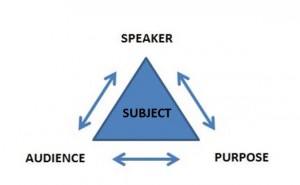The Tumblr Experiment, part 1: Introduction
 In an earlier post “I Am Not Your Audience,” I talked about moving students away from the idea that I’m the person for whom they write, as well as moving them away from thinking that the purpose of their writing is to “score points.” Neither is easy. Precious few people ever really talked to my students about an audience beyond the teacher, or a purpose for writing beyond getting a good grade.
In an earlier post “I Am Not Your Audience,” I talked about moving students away from the idea that I’m the person for whom they write, as well as moving them away from thinking that the purpose of their writing is to “score points.” Neither is easy. Precious few people ever really talked to my students about an audience beyond the teacher, or a purpose for writing beyond getting a good grade.
They seem to function in this mode: “I’m the speaker. You, my teacher, are the audience and, of course, my purpose, the only purpose, is to please you and get a high grade.”
That’s what kids are used to because that’s what they’ve been taught. But this isn’t how writing works in the real world. Being able to write well often means being able to read an audience and tailor a message in ways that make it effective. I don’t think voice develops without an audience. And I don’t think it develops with a static audience.
In order to become successful writers, my students need to get more out of that rhetorical triangle–Audience, Speaker, Purpose.

So I need to find a place where they can experiment with a real audience. Enter Tumblr.com, a microblogging platform where my students and I have been experimenting with ways to bend that rhetorical triangle.
What happened when I found a place where my students could explore their interests and develop their authentic voices? What happened when I set them free to write “like themselves,” to take risks and find a real audience…
They asked me how many points it’s worth.
In that first post, I promised to share what I learned–good and bad. In this series of posts, I’ll lay out my classes’ process and what I was hoping would happen–not always the same as what did happen–but if I’m going to move with my students into a place where expectations, audience and purpose are fluid, I have to be ready to adjust, and adjust we do. In fact, that ability to adjust, what people sometimes call rhetorical dexterity, is exactly what we’re after. In this series of posts, I’ll put our work out there for you to judge–not the students’ work, but whether or not this experiment is, if not working exactly, at least worth pursuing.
In addition to following these posts, I’m inviting anyone who wants to see the experiment in action to follow me on tumblr.com. Throughout the series, I’ll include the hashtags that we use to identify our posts. Hashtags are a way of identifying and grouping posts by subject. I try to make mine unique to my class so I use a prefix that identifies the class and year — aplang15 for my AP Language and Composition classes in 2015–and a suffix that connects to the assignment–art, workandplay, twain. The hashtag for the assignment on art is #aplang15art. It makes finding what I and my students are looking for on Tumblr easy.
So, have a look at what we’re up to. I’m not promising everything there is rhetorical gold or best practice or even “cutting edge,” just an experiment, a way to find out what me and my students think.
Find me on Tumblr here. To read the entries below, click to enlarge.
 Rick Kreinbring teaches English at Avondale High School in Auburn Hills, Michigan. His current assignments include teaching AP Language and Composition and AP Literature and Composition. He is a member of a statewide research project through the Michigan Teachers as Researchers Collaborative partnered with the MSU Writing in Digital Environments Program, which concentrates on improving student writing and peer feedback. Rick has presented at the National Advanced Placement Convention and the National Council of Teachers of English Conference. He is in his twenty-third year of teaching and makes his home in Huntington Woods.
Rick Kreinbring teaches English at Avondale High School in Auburn Hills, Michigan. His current assignments include teaching AP Language and Composition and AP Literature and Composition. He is a member of a statewide research project through the Michigan Teachers as Researchers Collaborative partnered with the MSU Writing in Digital Environments Program, which concentrates on improving student writing and peer feedback. Rick has presented at the National Advanced Placement Convention and the National Council of Teachers of English Conference. He is in his twenty-third year of teaching and makes his home in Huntington Woods.


 Click to read
Click to read